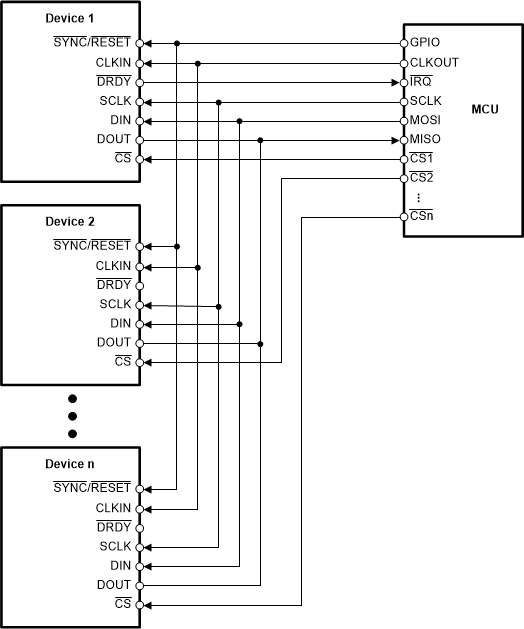ZHCSO81 November 2021 ADS130B04-Q1
PRODUCTION DATA
- 1 特性
- 2 应用
- 3 说明
- 4 Revision History
- 5 Pin Configuration and Functions
- 6 Specifications
- 7 Parameter Measurement Information
-
8 Detailed Description
- 8.1 Overview
- 8.2 Functional Block Diagram
- 8.3 Feature Description
- 8.4 Device Functional Modes
- 8.5
Programming
- 8.5.1
Serial Interface
- 8.5.1.1 Chip Select (CS)
- 8.5.1.2 Serial Data Clock (SCLK)
- 8.5.1.3 Serial Data Input (DIN)
- 8.5.1.4 Serial Data Output (DOUT)
- 8.5.1.5 Data Ready (DRDY)
- 8.5.1.6 SPI Communication Frames
- 8.5.1.7 SPI Communication Words
- 8.5.1.8 Short SPI Frames
- 8.5.1.9 Communication Cyclic Redundancy Check (CRC)
- 8.5.1.10 SPI Timeout
- 8.5.2 ADC Conversion Data Format
- 8.5.3 Commands
- 8.5.4 Collecting Data for the First Time or After a Pause in Data Collection
- 8.5.1
Serial Interface
- 8.6 Register Map
- 9 Application and Implementation
- 10Power Supply Recommendations
- 11Layout
- 12Device and Documentation Support
- 13Mechanical, Packaging, and Orderable Information
9.1.5 Multiple Device Configuration
Multiple ADS130B04-Q1 devices can be arranged to capture all signals simultaneously. The same clock must be provided to all devices and the SYNC/RESET pins must be strobed simultaneously at least one time to align the sample periods internally between devices.
The devices can share the same SPI bus where only the CS pins for each device are unique. Each device can be addressed sequentially by asserting CS for the device that the host wishes to communicate with. The DOUT pin remains high impedance when the CS pin is high, allowing the DOUT lines to be shared between devices as long as no two devices sharing the bus simultaneously have their CS pins low. Figure 9-3 shows multiple devices configured for simultaneous data acquisition while sharing the same SPI bus.
Monitoring the DRDY output of only one of the devices is sufficient because all devices convert simultaneously.
 Figure 9-3 Multiple Device
Configuration
Figure 9-3 Multiple Device
Configuration